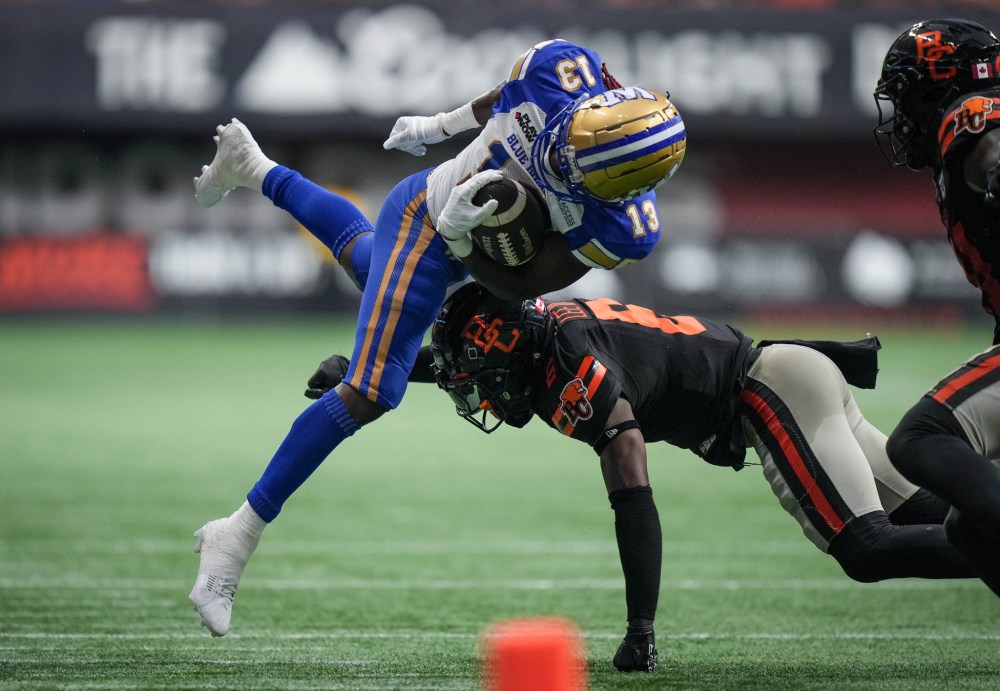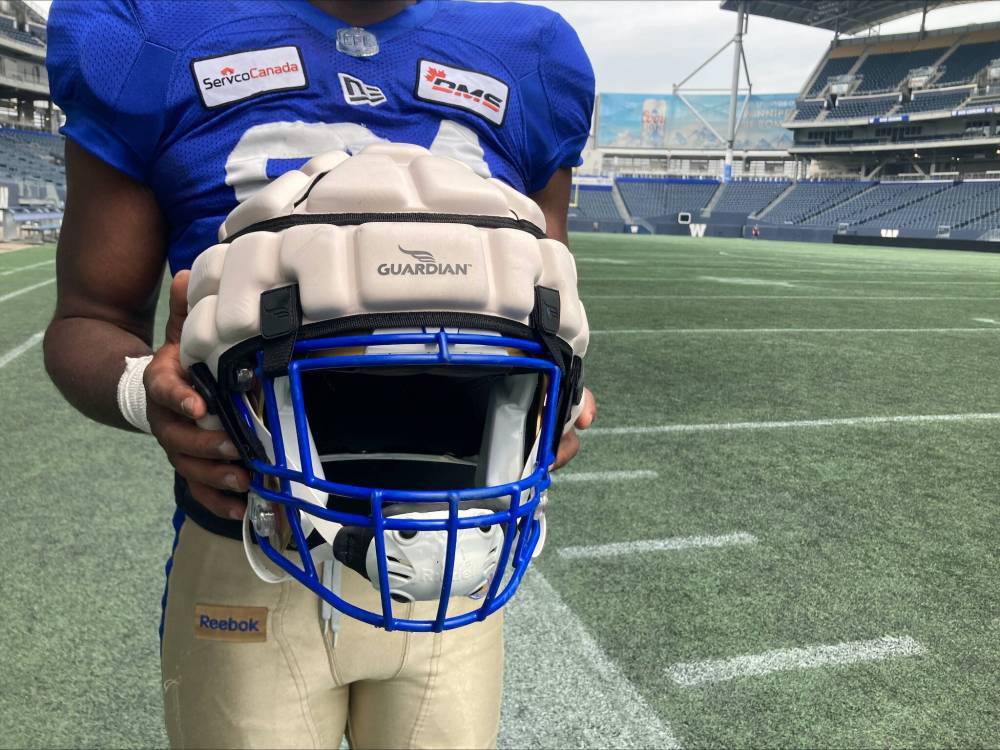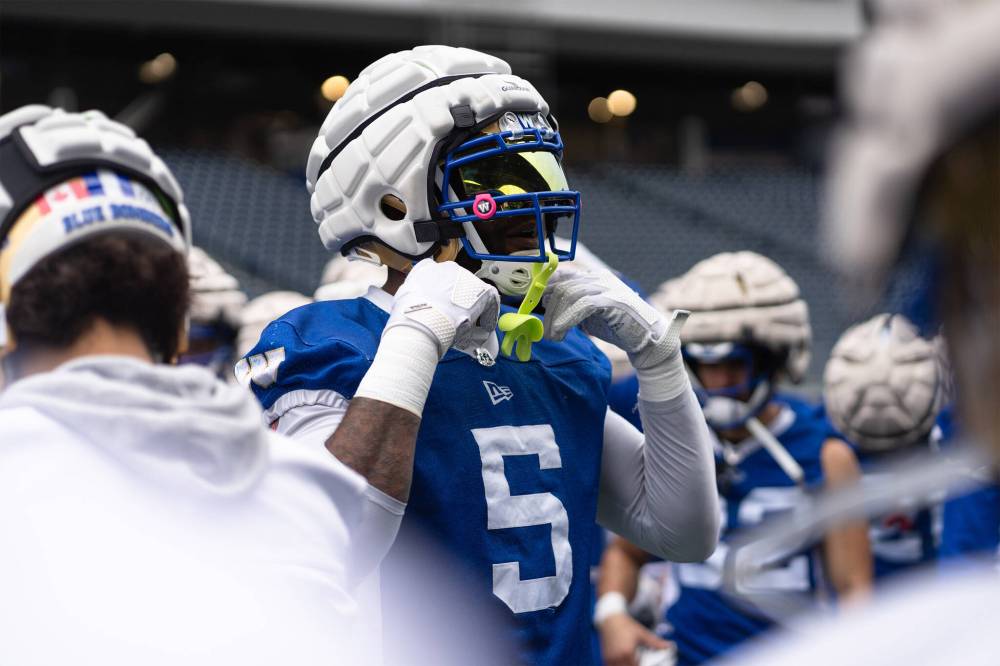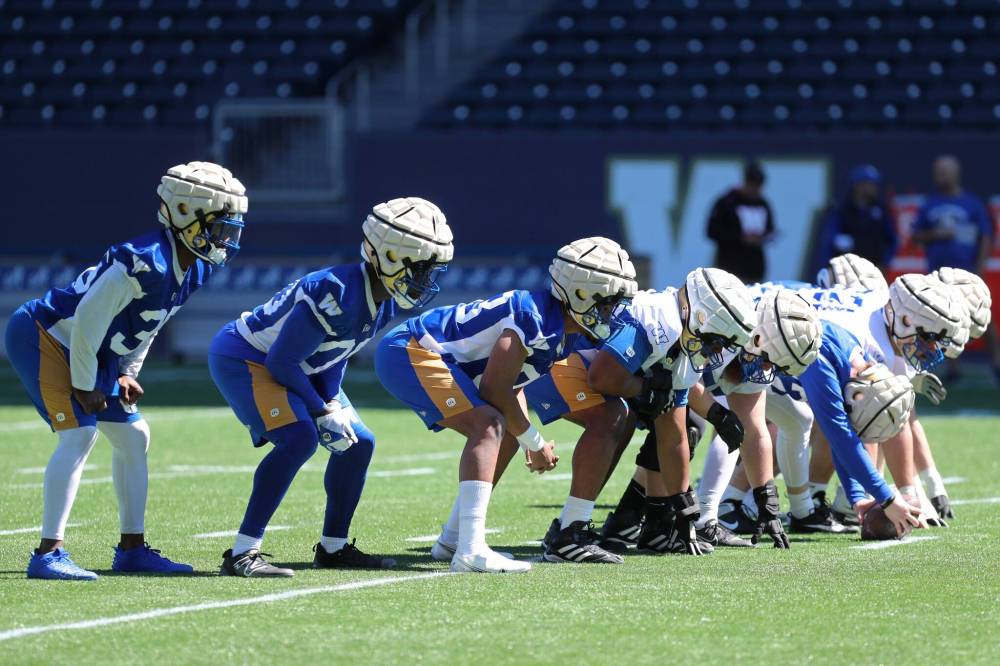Little headway on enhanced safety Few football pros have given the nod to donning helmet Guardian Caps that help guard against concussions
Read this article for free:
or
Already have an account? Log in here »
To continue reading, please subscribe:
Monthly Digital Subscription
$0 for the first 4 weeks*
- Enjoy unlimited reading on winnipegfreepress.com
- Read the E-Edition, our digital replica newspaper
- Access News Break, our award-winning app
- Play interactive puzzles
*No charge for 4 weeks then price increases to the regular rate of $19.00 plus GST every four weeks. Offer available to new and qualified returning subscribers only. Cancel any time.
Monthly Digital Subscription
$4.75/week*
- Enjoy unlimited reading on winnipegfreepress.com
- Read the E-Edition, our digital replica newspaper
- Access News Break, our award-winning app
- Play interactive puzzles
*Billed as $19 plus GST every four weeks. Cancel any time.
To continue reading, please subscribe:
Add Free Press access to your Brandon Sun subscription for only an additional
$1 for the first 4 weeks*
*Your next subscription payment will increase by $1.00 and you will be charged $16.99 plus GST for four weeks. After four weeks, your payment will increase to $23.99 plus GST every four weeks.
Read unlimited articles for free today:
or
Already have an account? Log in here »
Hey there, time traveller!
This article was published 23/10/2024 (383 days ago), so information in it may no longer be current.
It was another frightening hit in a series of near career-ending blows — Miami Dolphins quarterback Tua Tagovailoa slumped to the turf, his arms extending unnaturally into the air. It’s called a fencing posture, an involuntary position associated with traumatic brain injury.
For Tagovailoa, the collision with Buffalo Bills safety Damar Hamlin on Sept. 12 during National Football League action was his third diagnosed concussion in two years. Yet, when he returned to the practice field and to face the media this week, he was adamant about two things: no, he was not retiring, and no, he was not going to start wearing a Guardian Cap over his helmet to help protect his head.
“Nope,” he immediately answered.
“Personal choice,” he added.
Tua Tagovailoa (middle) suffered a concussion following a hit by Bills safety Damar Hamlin. 
When Tagovailoa — the NFL’s poster boy for head safety due to his extensive history with concussions — immediately dismissed the idea of wearing a Guardian Cap, it sent ripples across the football world, leaving many with more questions than answers about the future of the protective equipment.
The Guardian Cap is a padded shell affixed to the outside of a helmet. According to the Canadian Football League, research has shown it reduces the severity of impact by at least 10 per cent when worn by one player, and by at least 20 per cent when worn by both players in a collision.
The cap has slowly begun to appear in pro games this season on both sides of the border, but an overwhelming sentiment among players remains: wearing the protective equipment likely won’t catch on anytime soon.
The Guardian Cap was created in 2010 and introduced to the NFL in 2022 when the league mandated its players to wear it during training camp in hopes of limiting the number of concussions before the regular season. The move yielded a 50 per cent decrease in concussions during that time.
“Nope. Personal choice.”–Miami Dolphins QB Tua Tagovailoa
The CFL followed suit in 2023 but limited the mandate to offensive and defensive linemen, running backs and linebackers — positions that are most likely to be involved in a collision on any given play.
Ahead of this season, the NFL adjusted its rules to allow all positions the option of wearing the cap during games. However, only a handful of players have decided to do so — including Indianapolis Colts running back Jonathan Taylor, New England Patriots safety Jabrill Peppers and Tampa Bay Buccaneers offensive lineman Luke Goedeke.
The option to wear the shell in CFL games was introduced last off-season — along with a mandate for defensive backs and receivers to wear the cap during training camp — but only Saskatchewan Roughriders running back Thomas Bertrand-Hudon and B.C. Lions defensive back T.J. Lee have chosen to wear the extra layer of padding when they take the field.
Lee, a 10-year veteran in the league, made the decision after the Lions’ bye week in late September and plans to continue for the remainder of the season.
Winnipeg Blue Bombers' Lucky Whitehead (left) is upended by B.C. Lions' T.J. Lee during the game in Vancouver, B.C., in August. Lee made the decision to wear the cap in late September .

“Honestly, before, I was kind of hard against it. Just the normal football player rhetoric: ‘I don’t want to have too much stuff on,’” Lee told the Free Press recently.
“But I had a week to reflect during the bye week and I kind of just decided that I wanted to wear it, listening to my physical therapist from home and listening to my wife, and started to find reasons why it would work for me.”
Lee also has a history of concussions — three in his career that have been diagnosed — and recently switched to linebacker, which puts him in the fray more often.
“I always give my kids an example of protecting their head — I have three kids and I tell them to protect their heads — so it kind of bled into that, being the example that I want to be,” he said.
Lee was teased by teammates when he began to wear the cap full-time. The comments, Lee said, were not hurtful nor offensive, but rather playful jabs. He said it comes with the territory of being a proponent of change.
“When you’re a leader, you don’t mind being the first to do things and you’re gonna get criticism.”–B.C. Lions DB T.J. Lee
“It’s hard to make change in football because you have these prescribed mindsets,” said Lee, who has since convinced some teammates to be more open-minded about the cap.
“To stand out is hard as a football player because we prescribe to all these ways of thinking, and that’s one way for me as an individual that’s kept me around for so long. I’ve always changed a little bit about myself every year.
“When you’re a leader, you don’t mind being the first to do things and you’re gonna get criticism,” he continued. “There’s nothing but negative criticism about the helmet, but generally that comes before all the love and praise.”
The Athletic recently polled NFL players about the idea of wearing Guardian Caps during a game: 65 of the 109 players who responded were opposed, while 31 players gave it a thumbs up in general, even if they weren’t necessarily wearing one, and the remaining 13 were undecided.
Members of the Winnipeg Blue Bombers, for the most part, are in alignment with their counterparts south of the border.
The padded cap is attached to a regular helmet.
Several Bombers acknowledged the benefits of wearing extra padding when the intensity ratchets up, but none are prepared to commit to sporting the cap.
Their reasons varied — from its oversized look and the feel when wearing it — but a reoccurring sentiment was an unwillingness to make a change after playing their whole life without one.
“For me, it’s not even the look of it. The look is whatever … it’s just how it feels,” said running back Brady Oliveira, who refers to the caps as “marshmallow heads.”
“When you get contact, it’s like you bounce off, it’s too cushiony. I think the way I run the ball too, right, it’s very physical and you feel that when we wear them in training camp or when we have pads on, you kind of bounce off and I need to be going forward, not backwards.”
How about in the trenches, where head contact is almost a certainty in every play?
Willie Jefferson dons the Guardian Cap in training camp, but remains adamant he won’t wear it during games. 
“I grew up playing football without a Guardian Cap, right? So, I’m gonna continue playing football without the Guardian Cap,” said defensive end Willie Jefferson.
“I think guys that play football know the risk that comes with football, know it’s a physical game, know it comes with contact. Like I said, if we can wear them during practice to lessen the blows during the week… that’ll be a plus. But, for me, during the game, it’s a no.”
Centre Chris Kolankowski was part of the CFL/CFLPA mentorship program during the off-season with Eric Neovo, associate vice-president of health and safety and football operations with the league, and while he expressed an appreciation for the data that supports wearing the caps, he believes it’s detrimental to his play.
“Personally, when I’m hitting with the Guardian Cap, I feel a little more,” Kolankowski said.
“I think it’s because with helmets it’s not a direct square hit, it’s glancing blows, so you’re kind of deflecting off of each other. But with the Guardian Cap, those glancing blows don’t happen as much. It kind of sticks to it a little more, probably because of the shape, the texture and the material.
“That’s my personal take on it. Obviously, the CFL is using NFL research and we know how many resources the NFL is pushing into that. So that is the data but that’s just how I feel about them personally and I don’t like them.”
The CFL requires certain position players to wear the Guardian Caps during training camp in the hopes of reducing concussions.
Perhaps the unsaid part of those answers is what the Guardian Cap could symbolize to the opposition — a player who is fearful.
“It’s football,” Jefferson said. “You want that contact. You want that sense of aggression, that sense of power when you’re striking somebody, especially on the defensive side of the ball.
“I can understand if a guy on the offensive side wants to wear a Guardian Cap to protect himself because sometimes offensive guys get caught in a vulnerable position, but on the defensive side of the ball, you always have your head on a swivel, you’re looking for that contact, you want to lay that big hit.”
So, will the extra layer of protection ever catch on?
Dr. Dhiren Naidu, the CFL’s chief medical officer who has served on the International Collision Sports Group, said he believes it would need to be mandated by the league. The sports group also includes representatives from the NFL, NHL, International Ice Hockey Federation, Australian Rules Football, World Rugby and National Rugby League.
“A Canadian example is probably the face shields in hockey… where over time eventually the players association and the NHL came to an agreement that from a health-and-safety perspective that it’s best to go that way,” said Naidu, who has dedicated his entire career to concussion research.
“At this point, I don’t think we’re quite ready to do that.”
Football helmets have improved in recent years but still appear to miss the mark. Some now include extra padding to certain areas of the helmet, depending on a player’s position — linemen have extra padding at the front of their helmet because most of the blunt force is made with their face-mask area — but Naidu said the data hasn’t yet proved those designs help prevent concussions.
The research still has a long way to go, he added.
“To me, I don’t necessarily know if I see a game where everyone is wearing Guardian Caps out there,” Naidu said. “What I do hope is the Guardian Cap technology and the foams maybe get incorporated into newer helmet designs in the future.”
That’s all Kolankowski, and presumably his peers, want to see.
“Just make the helmets better,” Kolankowski said. “Stop trying to add stuff on. Just make the helmet itself better.”
joshua.frey-sam@freepress.mb.ca
X: @jfreysam

Josh Frey-Sam reports on sports and business at the Free Press. Josh got his start at the paper in 2022, just weeks after graduating from the Creative Communications program at Red River College. He reports primarily on amateur teams and athletes in sports. Read more about Josh.
Every piece of reporting Josh produces is reviewed by an editing team before it is posted online or published in print — part of the Free Press‘s tradition, since 1872, of producing reliable independent journalism. Read more about Free Press’s history and mandate, and learn how our newsroom operates.
Our newsroom depends on a growing audience of readers to power our journalism. If you are not a paid reader, please consider becoming a subscriber.
Our newsroom depends on its audience of readers to power our journalism. Thank you for your support.







